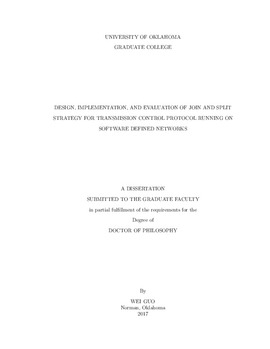| dc.description.abstract | Software Defined Networks (SDN)-enabled switches of today can be empowered to
intelligently forward as well as elastically steer the network traffic. In this work, we focus
on developing a SDN-based framework to provide improved delivery performance
(of applications) in the network.
This dissertation proposed a new TCP join and split proxy on SDN platform. The
proposed framework allowed part of TCP (Transmission Control Protocol) optimization
to migrate from the application server to the proxy. Therefore, with a control
plane built between SDN controller and proxy, the SDN controller can further improve
the TCP delivery performance. The proxy (join-proxy) joins all TCP flows at the
beginning of the shared path into one long TCP flow. At the end of the shared path,
the proxy (split-proxy) splits the long flow for each joined client with the same TCP
session state. With the help of centralized controller of SDN and customized SDN
switch, the new design simplifies the TCP session synchronization between proxies.
Also, this dissertation developed Linked-ACK ((Acknowledgement) to maintain the
end-to-end semantic and limit the buffer size in each proxy by coupling the ACK of
three TCP flows separated by the join and split proxy. At the last, this dissertation
shows that the proposed proxy can well integrate with wireless network and MPTCP
(Multi-Path TCP) proxy [1]
The extensions of the proposed TCP Join and Split platform are applied to Smart
Grid network for improving fairness, WiFi network for reducing gaming traffic delay,
and Data Center network for addressing Virtual Machine (VM) live migration
problem.
First, the proposed TCP Join and Split platform can be applied to Smart Grid
network to provide better fairness on the application layer. The latest research in
Smart Grid communications has advocated the aggregation of multiple traffic flows
in order to achieve an improved throughput. While aggregation improves the overall
throughput, the individual flows still suffer from unfair throughput performance. As
a result, the enablers for time sensitive Smart Grid services, such as load-shedding
which requires a timely report of data, are mostly affected.
This dissertation proposed a novel SDN-based framework to provide fairness among
smart-meters (SMs) through flow aggregation and scheduling. By exploring the SDN’s
flow-level manageability features, for the first time in this paper, we present an
implementation-based architecture to perform effective aggregation-and-scheduling
of traffic flows. The proposed framework ensures fairness (among the smart-meters)
as well as improve the throughput performance. Our extensive experimental results
validate the efficacy of our proposed framework.
Second, the proposed TCP Join and Split platform can be applied to WiFi network
to reduce the gaming traffic delay. WiFi users typically expect different performance
requirements for various types of applications. For instance, users expect 'better and
consistent throughput' for Internet video consumption, and 'minimal delay' for local
network gaming applications. The wireless access substrate (at the consumer-end),
typically being the bottleneck in these networks, causes different users (in the same
WiFi coverage) to experience unfair and fluctuating network performance. To combat
such unfair situations, we need approaches to effectively control and steer the
applications’ traffic in the shared WiFi medium. However, a network that deals with
a crowd or private end-users (such as gaming multiplayers or the Internet content distributors),
encounters a major challenge in controlling the traffic without involvement
or modification at the end-host application devices.
In this dissertation, we propose a SDN-based seamless traffic steering and control
strategy in order to provide effective application-specific delivery services, such as
reduced delay (for gaming traffic) and improved throughput (for video consumption).
Unlike simulation-based solutions, our approach is production-ready, as we have implemented
our framework on a real network testbed environment. With extensive
performance study and sufficient mathematical insight, we demonstrate the prowess
of our proposed framework.
Last but not the least, the proposed TCP Join and Split platform can be applied
to Data Center network to optimize the VM live migration. With the growth of data
volumes and a variety of Internet applications, virtualization has become commonplace
in modern data centers and an effective solution to provide better management
flexibility, lower cost, scalability, better resources utilization, and energy efficiency.
One of the powerful features provided by virtualization is Virtual Machine (VM) live
migration, which facilitates moving workloads within the infrastructure with negligible
downtime and minimal impact on workload. However, the performance of running
applications is likely to be negatively affected during a live VM migration. The objective
of this paper is to optimize the total performance degradation of concurrent VM
live migration in the data center network by exploiting the SDN platform. The problem
is modeled using mixed integer linear programming(MILP) for VM live migration
with a fixed path and VM live migration with path selection. To provide a practical
optimization, the greedy algorithm is proposed. Numerical study results show that
a significant decrease occur in performance degradation in MILP model and greedy
algorithm when the number of VMs increases. The proposed greedy algorithm cannot
yield the optimum solution as the problem become harder, but it provides better
solution than MILP model in terms of the time constrain exhibited in case of large
problems. | en_US |
